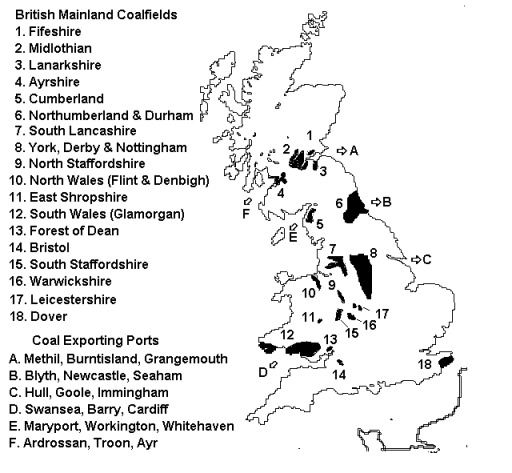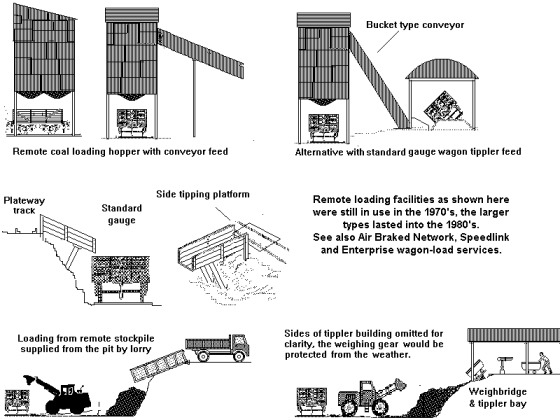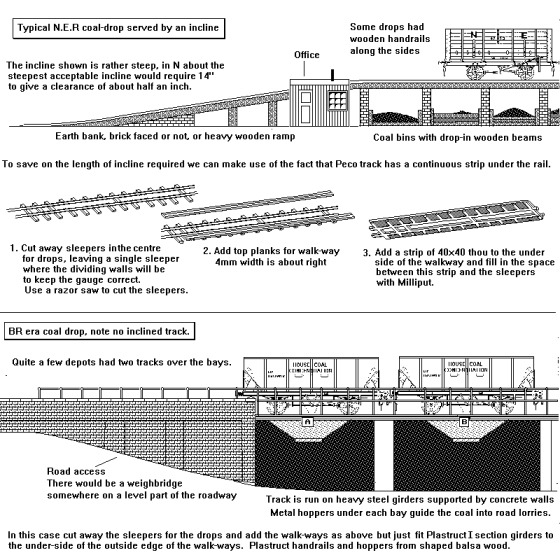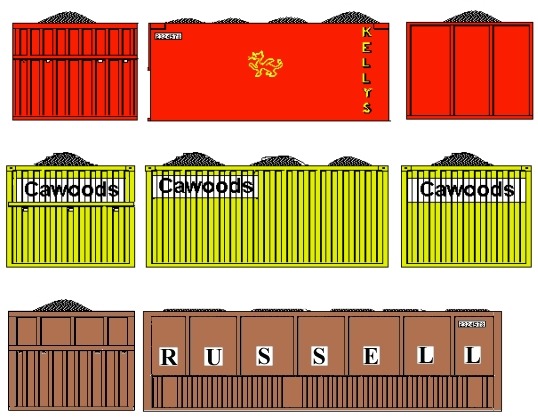The domestic gas fire only really caught on in the 1950's, prior to that most households had regular deliveries of coal and a small coal bunker, either in the yard or built into the house itself, was an essential feature of every home. In the early 1960's it was estimated that about 20% of the household refuse collected by the local corporations was ashes from coal fires. At that time the small private coal yard was still part of many station goods yards, at larger stations a separate coal yard was often provided, independent of the main goods yard. At one of my local stations (Altrincham, south of Manchester) there were more sidings in the coal yard than there were in the goods yard although this yard also supplied coal to the local gas works and handled the coke and chemicals traffic coming the other way.
Coal has always been moved in open wagons and open hopper wagons, although the size of the rolling stock has increased steadily over the years. The original chauldron wagons carried just over two tons, then in the latter half of the nineteenth century came the first standard open coal wagons carrying perhaps eight tons apiece. By the 1920's the ten ton wooden wagon was standard, although older eight tonners survived into the early 1950's. Twelve tonners were becoming common by the 1940's (this was the basis for the 1923 RCH coal wagon specification but it appears to have taken some time to catch on with users) and steel bodied wagons started to become more common at this time. The early years of British Railways saw a massive building program of 16 ton steel wagons of various designs and larger capacity twenty one ton and even twenty four ton steel wagons were also built in some numbers.
Before the second world war most coal wagons were private owner stock, most had wooden bodies and they were often rather old and dilapidated. The Southern Railway did provide some wagons for use in the Kentish coal areas and other railway companies built stock which they leased to private owners, notably the GWR with their `Felix Pole' steel bodied 20 tonners and the large wooden bodied hopper wagons on the North Eastern Railway/LNER.
Block trains of coal were actually the exception rather than the rule in the pre-BR days, other than those feeding power stations or running to the docks for export. A colliery might send out a rake consisting of wagons for several different destinations, these would be hauled by the railway to the nearest marshalling yard to be sorted. At the marshalling yard the rake would be broken up and individual wagons or short 'cuts' of wagons would be attached to mixed goods rakes going to various destinations on the system. Coal therefore neatly bridges the gap between block trains and single wagon load traffic.
There was so much coal moved however that block trains of coal would regularly be seen anywhere remotely near a colliery. Such a train might consist of as many as 150 or so wagons in the Big Four era. The main limiting factor was the length of the loops or refuge sidings provided so the slow coal train could get clear of the line to allow a passenger service or express goods train to pass. In N gauge you would need sidings about twenty feet long to accommodate such a train and I doubt many 'N' loco's could pull such a rake round any typical model railway curves.
Fig___ British mainland coal fields and associated ports

Coal was usually loaded into railway wagons at the mine, however a coal mine, even a small one, takes a fair bit of space and requires quite a lot of model making (coal mines are discussed in more detail under Lineside Industries). An alternative is the remote loading facility, these could deal with coal from a number of smaller pits or might simply offer a siding with a chute to collect coal from a small mine (examples of the latter were seen in the Forest of Dean).
Fig___ Remote Coal Loading Facilities

All the sketches in the above illustration were made from photographs. In the example shown in the lower left the 'chute' into which the lorries tip was actually a redundant tipper lorry body, photographed in the late 1970's or early 1980's. The body from the new Knightwing lorry kit could be used for this, well rusted, and the cab and chassis could then form a handy wagon load.
A lot of coal was delivered to local coal merchants, these usually rented space in the local station goods yard and generally had a siding or two reserved for their use. My local station in Hale actually had two separate coal yards, operated by different merchants, but it would be quite possible (though not common) for two merchants to 'share' a siding. The larger coal yard just up the line at Altrincham was shared by several merchants, but that was a separate yard with loops and a number of sidings. The coal merchants yards forming part of the station goods yard are discussed separately under Freight Operations - Railway Company Goods Facilities. That section also discusses how the coal was handled by the merchants.
Prior to the Second World War coal wagons other than in the North East were mainly private owner stock of simple design dating back to the early twentieth century. They were usually wooden bodied, loose-coupled, with a short wheel base and low capacity. Some were end-door types that could be tipped up to empty them, a practice favoured when feeding docks and larger industrial users. Many had some form of bottom doors and if a wagon's side door was damaged these bottom doors might be used to get the coal out with the assistance of some men with shovels.
Wagons fitted with end-doors could be tipped up using a section of hinged track and in some locations wagons with only side doors were emptied by opening the side door and tipping the wagon over sideways. To hold the wagon in check a heavy chain with a hook on the end was slipped over the top of the wagon side. This latter system was sometimes used to feed coal into railway company mechanical locomotive coaling towers.
With the introduction of steel bodied stock came the rotary tippler in which the wagons are physically turned upside down and this system was widely used for sand and iron ore traffic in BR days. Fortunately for the modeller the tippler itself is usually located inside a shed of some form although at least one working tippler has been built in N gauge.
In the North East there was a tradition of using hopper wagons although these were themselves wooden bodied. The disadvantage was that hopper wagons need a raised track or an excavated pit to empty into, adding to the cost. This made them unpopular with private traders who would have to build such an arrangement themselves. In the North East the railway companies built the coal drops and leased these to the traders.
Following nationalisation in 1947 private owner wagons were quickly phased out and all coal was moved in British Railways rolling stock, mainly the British Railways standard 16 ton open wagons. In the North East however the coal drops remained in use and British Railways actually built a number of wooden bodied hoppers to a basically pre-1923 NER design to serve these (see Historical Background section).
The 'Clean Air Act' was passed in December 1956, following a severe smog in 1952 that had killed about 4,000 people in and around London and another (earlier in 1956) that spread over several counties. Smog is a fog with a lot of dirty smoke in it, they were fairly common in towns close by water such as rivers. The Act gave local authorities the power to establish 'smokeless zones' in which only 'smokeless fuels could be used. Smoke free zones soon proliferated but the bulk of the country continued to use bituminous coal and the severe smogs continued for many years (one quite bad one occurred as late as 1962). The smokeless zones required smokeless fuels, initially these cost about half again as much as coal which is why they were not simply adopted by everyone as a matter of course. Anthracite coal is effectively smokeless but most smokeless fuels are made of pulverised coke mixed with a binding agent and formed into briquettes about the size of a bar of soap. As it is based on coke, and hence lighter than coal, smokeless fuel was often moved in high sided (7 or 8 plank) wagons with coke rails fitted to increase their capacity. There is a photograph of a private owner wagon in the Historical Model Railway Collection bearing the livery of a pre-war smokeless fuel merchant. The catalogue describes the picture as being of an Ex Suncole Smokeless Nottingham Fuel 13T 8 plk + coke rails P192891 Side and end door. Photo by M.Ruggles. Side view. Date/loc unknown paint date may be 1948. From which we may deduce that there had existed a substantial market for smokeless fuels for many years prior to the Second World War. The first patent on a method of making smokeless fuel actually dates back to 1620 when Sir William St. John devised a process using a 'beehive kiln' to turn coal into coke. By the 1920's the various agencies in the USA were recommending coke as a smokeless fuel to reduce smog (they had a range of other fuels, solid, liquid and gas in use at the time, many of which produced thick smoke). I believe smokeless fuel was a distinctly marginal industry in the UK until the Clean Air Act but just how big the margin was, and what special purposes the smokeless fuel may have been used for, I have not been able to establish.
The pattern of domestic coal distribution changed in the later 1960's, the transport Minister, Mr. Marples, following the recommendations made by Mr. Beeching and his team, encouraged a shift toward block working. This saw the end of deliveries to smaller individual coal merchants sidings, instead the coal and smokeless fuel was shipped to the new Coal Concentration Depots from where it was delivered by road, pre-bagged or in bulk, to the local traders.
Some larger coal merchants with large rail served depots (usually on the site of a former station goods yard) continued to receive wagon loads of coal up to about 1970. I distinctly remember a couple of coal wagons on the single siding at a small local station (Heald Green) in the early 1970's, however these may have been simply abandoned as not worth collecting. The entire former goods yard was by this time the coal merchant's yard with substantial stockpiles banked up in pens made of old oil drums and a mechanical shovel for lifting the coal into the bagging machine. Coal merchants with large sail served depots such as Charringtons, warranted train load deliveries and these continue today.
The coal concentration depots favoured the hopper wagon to reduce handling and British Railways began to use hopper wagons whenever possible for coal traffic. The standard British Railways coal hopper design was a 21 ton four wheeler (TOPS coded HTO or HTV) based on a 1930's design used on the pre-war LNER system. Where there was a shortage of coal hoppers iron ore hoppers were regularly pressed into service. Long rakes of hoppers were often seen running to the coal concentration depots as block trains, a typical depot would take perhaps eight of the British Railways 21 ton hoppers at a time.
The million or so 16 ton steel end-door wagons already in service continued to operate, in diminishing numbers, up to the mid 1980's. The steady decline in the use of house coal, coupled with the problems for the local trader in getting his coal from the concentration depot to his premises, saw the gradual demise of rail haulage. Today coal is only moved as block loads, most is block 'merry-go-round' workings en route to power stations, steel works and the like but some is still carried to coal dealers yards. (Merry go round services are discussed separately).
Fig___ Coal Drops

In 1970 coal and smokeless fuels made from coal accounted for about 70 percent of household heating but consumption then fell quite rapidly. In the later 1970's (following the 1973 oil crisis) the government encouraged industrial users to switch from oil to coal but in the early 1980's they were persuaded to encourage a switch to North Sea Gas, allowing this to be sold at cut rates and even encouraging the building of gas rather than coal fired power stations.
For air braked services the standard British Railways for supplying domestic coal distribution centres and minor industrial users (who did not warrant a merry-go-round service) was the manually discharged hopper HBA wagon. Although air braked, the original HBA wagons were piped for working with vacuum braked stock such as the original BR standard HTV 21 ton hoppers and designed to run at a maximum speed of 45 mph in line with the existing vacuum brake coal distribution services of the day. Mixed rakes were common and the vacuum fitted HTV 21 ton hoppers saw out the 1980's in some locations.
The HBA wagons were also used to carry coal and coke to some larger industrial locations, notably the steel works at Scunthorpe, where the large lumps of coke sometimes fouled the doors on the HAA 'Merry Go Round' type wagons.
A body kit for the HBA/HEA is available from Taylor Plastic Models, designed to fit the Peco fifteen foot wheelbase chassis.
Up to 1984 domestic coal was run as block loads, as the use of coal declined this became increasingly uneconomic. In 1983 and 1984 the HBA hoppers were revamped to run at 60 mph and recoded HEA, this allowed them to be moved in Speedlink wagon load services. About two thousand wagons were converted but due to an abrupt change in circumstances caused by the 1984/85 miners strike only fifteen hundred or so ended up in service on domestic coal duties.
In 1984 the domestic coal traffic, with the new HEA wagons to carry it (and the scrap metal traffic) were both fully integrated into the Speedlink air braked wagon load service network. This change meant an end to vacuum braked wagons and the scrap metal traffic was shifted over to leased air-braked wagons with (I believe) a few BR built wagons on redundant air-braked chassis.
The integration of the domestic coal services into Speedlink was not entirely successful as coal's needs did not fit well with the Speedlink operational pattern and in the mid 1980's Speedlink worked with the National Coal Board to establish a domestic and minor industrial user delivery service using separate block trains made up of dedicated locomotives and rakes of HEA hopper wagons. This new way of working was fully implemented in 1987, initially called the Network Coal Initiative it was later rebranded as the Speedlink Coal Network.
The plan was to offer deliveries of as little as 100 tons a year to lesser users supplied by a network of forty collieries offering good quality domestic coal and ten or so collieries and factories offering smokeless fuels. By the late 1980's, mainly due to the contraction of business caused by the miners strike, collections were made from only 28 collieries and smokeless fuel plants. These fed a system of seven major marshalling yards, shared with the train-load coal sector, from which deliveries were made to thirty seven domestic fuel concentration depots and two factories with private sidings. The trip workings to customers were usually once per day, motive power was supplied by pairs of class 20 loco's or later by single class 37 locomotives.
The 20-25 ton payload of the HBA/HEA wagons represented a significant improvement on infrastructure use compared to the older vacuum braked hoppers and steel end door wagons but hoppers require dedicated discharge facilities. In many cases the old pre World War Two coal drops remained in use, this was the case at Stockport on the old LNWR line south of Manchester, whilst in newly built installations conveyors fed from an under-track pit were provided. In the mid 1980's a machine called an over-rail-under-loader appeared, this has a pan which can be slipped under the wagon but above the rails feeding a conveyor belt. These latter were used at Mossend, Oxford and Bow and possibly at other sites on the system.
The domestic coal business continued to contract, by 1990 there were no Network Coal services south of London and the remaining rail deliveries using the HEA hoppers ceased in 1993.
Coal Containers
Meanwhile in the mid 1980's a company called Cobra containers had produced a number of coal containers to standard ISO specifications but with a reduced overall height. These can be handled using standard ISO container gear (or large fork lift trucks) but can be moved on standard height railway wagons.
The first examples were twenty feet long and ran on specially built drop-centre wagons allowing them to fit under the loading screens at he pits (Coedbach, Onllwyn, Gwaun-Cae-Gurwen) which had been built to feed the old 21 ton mineral wagons (TOPS MDO and MDV). An early adopter was Kelly's who used twenty foot containers in their livery for exports of coal from Wales to Ireland. Kelly's had the boxes loaded, sitting on the wagons, at the washeries of the Welsh pits and they went as a block load to the docks where they were loaded onto ships for Ireland. Cawoods also adopted the twenty foot containers for Irish exports (and possibly some mainland coal distributions work, but I cannot confirm that). I do not believe either of these container services ran as wagon load traffic in Speedlink services, they were both block train operations.
Brian Williams explained to me that coal traffic to Scotland was important enough to retain, but served too widespread an area to justify household coal concentration depots as seen elsewhere. Thus a load of surplus flat (SAA) and van (VCA) underfames were modified to carry reduced height open ISO style boxes to a number of centres, where the boxes were transhipped to road for final delivery. The wagons were coded FPA. Due to the reduced height, the boxes were 30' long, allowing them to carry about the same tonnage as the twenty foot boxes mentioned above. In 1982 a Scottish firm called Russels adopted the FPA and its thirty foot container for deliveries to their domestic coal distribution depots. The earlier type is illustrated below, there was a second design with less complex ribbing on the lower sides but I have not been able to find a colour illustration of these. Both Russel 30 foot types are available from Taylor Plastic Models, see below. All three users operated these containers in their own house livery. The sketches below are based on my notes and sketches from my notebooks and may be incorrect in detail.
Fig___ Coal Containers

My note book says the Kelly's containers were red with possibly yellow markings. Cawoods used yellow containers with the firms name in black either vertically on the left hand end or in large letters centrally on the sides. The early type of Russel containers were all over orange-red, the company name and wagon number are in black letters on white rectangles. The later type of container is dark grey and has the firms name in blue on a vertical white patch toward the left hand end of the container. Brian Williams informs me that the original Kelly's wagons were sold to the Ministry of Defence in the early 1990's but in 2001 Cawoods received a grant to refurbish 81 open top containers (size unspecified) with end doors required for the continuation of coal flows from collieries at Selby, Clipstone and Daw Mill to Seaforth for onward shipping to Northern Ireland. The Russel containers were still operating in 2003.
I believe the twenty foot containers have been used to carry rock salt (moved as a block load with pairs of containers carried on bogie FLA wagons) and the thirty foot long ('Russel' type) containers have also been used to carry other products, including beetroot for Baxter's from Ely and animal foods.
Models of both the original and the more recent Russel type containers and the associated FPA wagon are available from Taylor Plastic Models. The model runs on the Graham Farish/TPM four wheeled modern air-braked chassis with an open-frame insert (so it can be run empty). I believe the maximum height allowable for an eight foot wide container on a standard chassis is seven feet six inches, however the Russel containers are only six feet six inches high. Even at this height they cannot be loaded to capacity as this would exceed the axle weight of the delivery lorries so they normally carry twenty odd tons of coal. The Russel type are often stacked (up to four high) in the yard but some are lifted onto tipper lorries and emptied onto stockpiles in the yard. They are moved about and lifted on and off the wagons using large fork lift trucks (see also Railway Company Goods Facilities - Container Handling).
In the later 1980's it would be quite normal to see a domestic coal service train consisting of ten to fifteen four wheeled FPA (thirty foot) container wagons with ten to fifteen HBA hoppers tagged on the rear. The containers have a door in the lower part of one end, they are lifted onto a lorry equipped with tipping gear for the final road leg of the journey. The hoppers would be routed to a rail served coal depot or one of the minor industrial users (the latter would travel as wagon load traffic in a Speedlink trip service).
I believe BR stopped supplying domestic coal and coal for smaller industrial users in its own wagons in 1993. The containerised coal traffic continued at that time, although the remaining Speedlink wagon load services had ended in 1991 so these must have been operated as block trains until 1993 when some may have been moved in the new Enterprise wagon load services.
Following privatisation EWS has invested heavily in new high capacity coal hopper wagons. In 2002 they ordered a final batch of 300 wagons from the York based wagon supplier Thrall Europa. This was part of a five year £200 million investment programme for a package of 2,500 wagons of various types. EWS has purchased a total of 1145 new coal wagons of various types since 1998. The new hopper wagons haul 40 percent more coal than traditional wagons in a standard train size and are designed to operate at 75mph.
The government has set a target of an eighty percent increase in rail hauled freight by 2010 (although this will remain a small percentage of the total freight moved in the UK), investment on this scale makes that target look like a practical proposition.